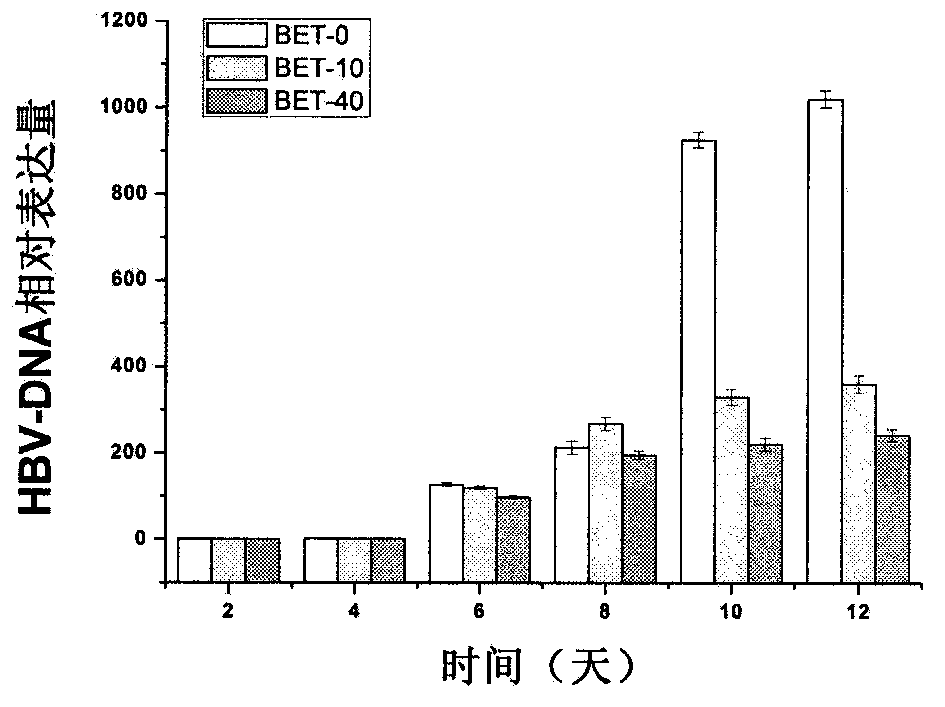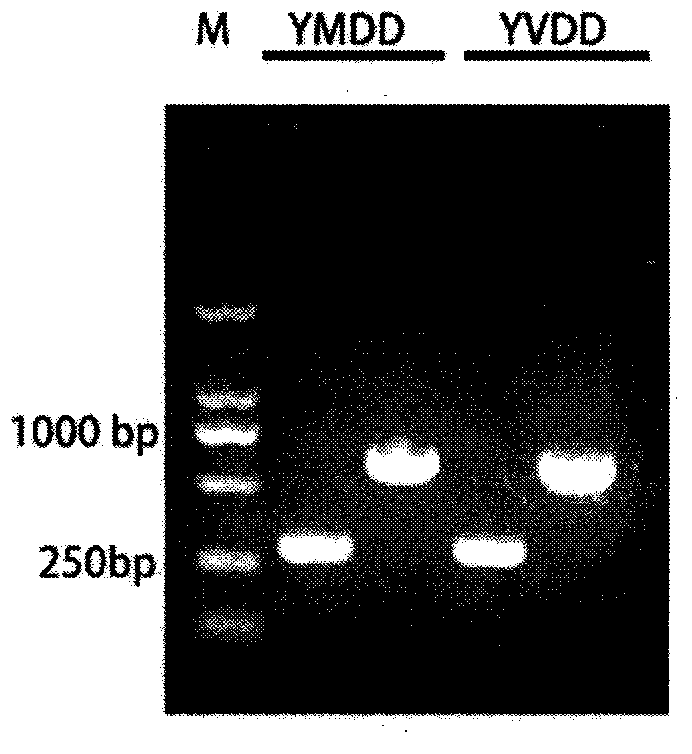Application of betaine hydrochloride in preparing medicines and health foods for preventing and treating hepatic diseases
A technology for betaine hydrochloride and liver disease, which is applied in the application field of medicine and achieves the effects of simple chemical synthesis, low price, and enhanced virus effect
- Summary
- Abstract
- Description
- Claims
- Application Information
AI Technical Summary
Problems solved by technology
Method used
Image
Examples
Embodiment 1
[0029] Example 1. Anti-hepatitis B virus effect of betaine hydrochloride and its combination with α-interferon in vitro
[0030] HepG 2.2.1.5 cell line is a HBV-DNA transgenic liver cancer cell line established abroad that can actively secrete hepatitis B virus. It is derived from HepG2 liver cancer cells. Interferon can inhibit the proliferation of hepatitis B virus through its intracellular signaling pathway, and lamivudine is a nucleoside analog that can directly inhibit viral DNA replication. By detecting the contents of HBsAg, HBeAg and HBV DNA in the culture supernatant of HepG 2.2.1.5 cells, the antiviral effect of lamivudine and the biological activity of α-interferon can be identified. In this example, betaine hydrochloride was used in combination with α-interferon, and lamivudine was used as a control to act on the 2.2.1.5 cell line to observe their inhibitory effect on the proliferation of hepatitis B virus.
[0031] 1. Materials and methods
[0032] 1.1 Materials...
Embodiment 2
[0065] Embodiment two, the inhibitory effect of betaine hydrochloride on the resistance mutation of the nucleoside antiviral drugs of HBV-DNA
[0066]Principle: Nucleoside anti-HBV drugs can induce drug-resistant mutations in HBV to varying degrees, thus increasing the difficulty of clinical treatment. HepG2.2.15 cells can secrete HBV virus particles, and lamivudine can increase the proportion of HBV mutants in the cells. This example designs a method for detecting low-abundance HBV mutants, and observes the inhibitory effect of betaine hydrochloride on HBV mutations induced by lamivudine.
[0067] 1 Materials and methods:
[0068] Cell culture and general materials are the same as in Example 1.
[0069] 1.1 Cell culture: with embodiment 1.
[0070] 1.2 Construction of plasmids containing YMDD, YVDD, and YIDD respectively: HBV-DNA was used as a template and s-YMDD in Table 6 was used as a primer to amplify a 600bp HBV-DNA fragment centered on YMDD. After digestion with Hin...
Embodiment 3
[0093] Embodiment three, the antiviral action of betaine hydrochloride to duck hepatitis B virus
[0094] Principle: Duck hepatitis B virus (DHBV) is a hepatitis model of duck natural infection, and is a commonly used animal drug efficacy model for testing drugs against the proliferation of hepatitis B virus. It is known that lamivudine can directly inhibit the DNA replication of hepatitis B virus in ducks. By detecting the content of DHBV-DNA in duck serum, the antiviral activity of the drug can be determined. In this example, lamivudine was used as a control to observe the anti-hepatitis B virus effect of betaine hydrochloride.
[0095] 1. Materials and methods
[0096] 1.1 Reagents: 32P-dCTP and Notch Translation Kit (Promega); Betaine Hydrochloride (Amresco); Lamivudine (LAM, GlaxoSmithKline).
[0097] 1.2 Animals: Male one-day-old Longyan Shelduck, purchased from the hatchery of Chaoyang Village, Shijing, weighing about 50 grams per bird, was reared conventionally. Br...
PUM
 Login to View More
Login to View More Abstract
Description
Claims
Application Information
 Login to View More
Login to View More - R&D
- Intellectual Property
- Life Sciences
- Materials
- Tech Scout
- Unparalleled Data Quality
- Higher Quality Content
- 60% Fewer Hallucinations
Browse by: Latest US Patents, China's latest patents, Technical Efficacy Thesaurus, Application Domain, Technology Topic, Popular Technical Reports.
© 2025 PatSnap. All rights reserved.Legal|Privacy policy|Modern Slavery Act Transparency Statement|Sitemap|About US| Contact US: help@patsnap.com



